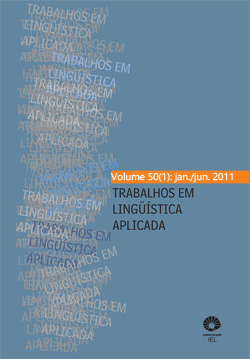Resumo
Nos últimos anos houve um aumento considerável de pesquisas sobre os aspectos prosódicos na fala e maior consciência da entoação como portadora de significado. Também a abordagem comunicativa supostamente provocou uma mudança no ensino da pronúncia: focalizou os traços suprassegmentais como ritmo e entoação. Este estudo pretende examinar até que ponto os alunos falantes de espanhol da Universidade Nacional Autônoma do México (UNAM) são capazes de distinguir entre os padrões entoacionais de afirmações e perguntas do tipo sim / não em português, dado que as duas línguas apresentam diferenças, sobretudo nas perguntas. Discutem-se também propostas para facilitar a aquisição dos traços supra-segmentais no ensino destas duas línguas próximas
ABSTRACT:
During the last few years there has been an increase in research of prosodic aspects of speech as well as a greater awareness of intonation as conveyor of meaning. The communicative approach is also considered to have provoked a change in the teaching of pronunciation of pronunciation: it focused on suprasegmental features like rhythm and intonation. This study examines to what extent Spanish-speaking students of Portuguese at the Universidad Nacional Autónoma de México (UNAM) are able to distinguish between the intonation patterns of statements and yes / no questions in Portuguese, since the two languages present differences, especially in the questions. Some proposals of how to facilitate the acquisition of suprasegmental features in teaching these two related languages are also discussed.
Keywords: Acquisition of intonation patterns, statements, yes / no questions in Portuguese
Referências
AVILA HERNÁNDEZ, S. (2004). La entonación del enunciado interrogativo en el español de la ciudad de México. In: HERRERA. E. & P. MARTÍN BUTRAGUEÑO (orgs.) La tonía: dimensiones fonéticas y fonológicas. México: El Colegio de México, p. 331-355.
BRAZIL, D.; COULTHARD, M. & JOHNS, C. (1980). Discourse intonation and language teaching. London: Longman.
CARROLL, J. B. (1981). Twenty-five years of research on foreign language aptitude. In: K.C. DILLER (ed.).
Individual differences & universals in language learning aptitude. Rowley, Mass.: Newbury House, p.
-118.
CELCE-MURCIA, M.; BRINTON, D. M. & GOODWIN, J. M. (1996). Teaching pronunciation. A reference for teachers of English to speakers of other Languages. Cambridge: Cambridge University Press.
CHUN, D.M. (2002). Discourse intonation in L2. From theory to practice. Amsterdam: J. Benjamins.
DA SILVA GOMES, M. H. et al. (1988). Curso ativo de português. México: CELE/UNAM.
DOUGHTY, C. & WILLIAMS, J. (orgs.) (1998). Focus on form in classroom second language acquisition.
Cambridge: Cambridge University Press.
GILBERT, J. B. (1980). Prosodic development: Some pilot studies. In: R.C. SCARCELLA & S.D. KRASHEN (orgs.) Research in second language Acquisition. Selected papers of the Los Angeles Second Language Acquisition Research Forum, Rowley, Massachusetts: Newbury House, p. 110-117.
GILBERT, J. B. (1984). Clear speech: Pronunciation and listening in American English. Cambridge: Cambridge University Press.
_____. (2008). Teaching pronunciation. Using the prosody pyramid. Cambridge: Cambridge University Press.
GUBÉRINA, P. & RIVENC, P. (1961). Voix et images de France. Paris: Didier.
HALLIDAY, M.A.K. (1970). A course in spoken English: Intonation. London: Oxford University Press.
HERRERA. E. & MARTÍN BUTRAGUEÑO, P. (orgs.) (2004). La tonía: dimensiones fonéticas y fonológicas, México: El Colegio de México.
HIRST, D. & DI CRISTO, A. (orgs.) (1998). Intonation systems. Cambridge: Cambridge University Press.
HUALDE, J. I. (2003). El modelo métrico y autosegmental. In: Prieto, P. (org.), Teorías de la entonación, p.
-184.
KRASHEN, S. (1981). Second language acquisition and second language learning. Oxford: Pergamon.
KRASHEN, S. & TERRELL, T. (1983). The natural approach: Language acquisition in the classroom. Oxford: Pergamon Press LONG, M. H. (1991). Focus on form: A design feature in language teaching methodology. In: K. de Bot, R.
Ginsberg & C. Kramsch (eds.). Foreign language research in crosscultural perspective. Amsterdam: J.
Benjamins, p. 39-52.
MORAES, J. A. de (1998). Intonation in Brazilian Portuguese. In: D. Hirst & A. Di Cristo (orgs.) Intonation Systems, p. 179-194.
PIERREHUMBERT, J. (1980). The phonology and phonetics of English intonation. MIT.
PRIETO, P. (org.) (2003). Teorías de la entonación. Barcelona: Ariel.
RENARD, P. (1979). Introduction à la méthode verbo-tonale de correction phonétique. Paris: Didier.
SCHMIDT, R. (2001). Attention. In P. ROBINSON, Cognition and second language instruction. Cambridge: Cambridge University Press, p. 3-32.
WIDDOWSON, H. G. (1978). Teaching language as communication. Oxford: Oxford University Press.
WILKINS, D.A. (1977). Notional syllabuses: A taxonomy and its relevance to foreign languag curriculum development. Oxford: Oxford University Press.
WILLIAMS, J. (2005). Form-focused instruction. In E. Hinkel (ed.) Handbook of research in second language teaching and learning. Mahwah, N. J.: L. Erlbaum.
O periódico Trabalhos em Linguística Aplicada utiliza a licença do Creative Commons (CC), preservando assim, a integridade dos artigos em ambiente de acesso aberto, em que:
- A publicação se reserva o direito de efetuar, nos originais, alterações de ordem normativa, ortográfica e gramatical, com vistas a manter o padrão culto da língua, respeitando, porém, o estilo dos autores;
- Os originais não serão devolvidos aos autores;
- Os autores mantêm os direitos totais sobre seus trabalhos publicados na Trabalhos de Linguística Aplicada, ficando sua reimpressão total ou parcial, depósito ou republicação sujeita à indicação de primeira publicação na revista, por meio da licença CC-BY;
- Deve ser consignada a fonte de publicação original;
- As opiniões emitidas pelos autores dos artigos são de sua exclusiva responsabilidade.

